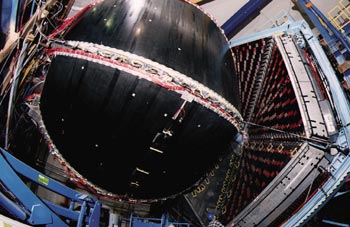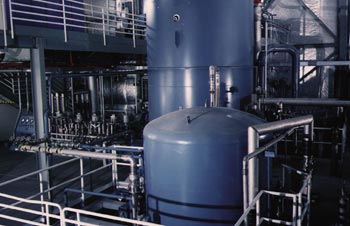Founded in the 1980s as the Continuous Electron Beam Accelerator Facility (CEBAF), the US national laboratory on Chesapeake Bay adopted the name of Thomas Jefferson in 1996. America’s third president would have been proud.
Thomas Jefferson is remembered as the man who penned the US Declaration of Independence. Less well known is his leadership of his era’s scientific enterprise. Jefferson graduated from the College of William and Mary and founded the University of Virginia – institutions that two centuries later led the formation of the Southeastern Universities Research Association (SURA), which runs Jefferson Lab (JLab) for the US Department of Energy. With the recent addition of the Massachusetts Institute of Technology, SURA now incorporates 59 institutions. As well as carrying out essential basic and applied research, JLab also runs an innovative science education programme with local schools.
JLab’s mission is to investigate the boundary between nuclear and particle physics, with the aims of understanding the forces between quarks and how hadrons are constructed from quarks, and of exploring the limits of our understanding of nuclear structure. Its history goes back to the mid-1970s, when scientists identified the need for a new tool to address emerging questions about the quark structure of matter. SURA’s proposal for a 4 GeV linear accelerator and pulse-stretcher ring was selected after the ensuing call for proposals. In 1984 Newport News, Virginia was chosen as the home of the future laboratory.

The laboratory’s first director, Hermann Grunder, came from Berkeley the following year to set up the new facility. His team soon threw out the original design and replaced it with something radically new. By then, it was clear that over the lifetime of the laboratory, a beam energy of 4 GeV would not be enough. The new proposal was to build a pair of superconducting linacs with bending arcs to recirculate the beam up to five times. This would give a high-energy beam with very low energy spread and emittance, and with an intrinsically continuous wave (CW) time structure. These factors are the keys to JLab’s success in taking our understanding of nucleon structure to a new level. A conceptual design report was ready in 1986, and through a fruitful collaboration with Cornell University, an accomplished centre for superconducting radiofrequency (SRF) accelerator technology (see Cornell’s laboratory is at the crossroads), the Continuous Electron Beam Accelerator Facility (CEBAF) was fully operational at an initial 4 GeV by 1997.
Probing hadron structure
CEBAF uses the electromagnetic interaction to probe hadron structure. It is a 1500 MHz machine serving three experimental halls with interlaced 500 MHz beams. The beams in all three halls have the same CW time structure, but their intensities can be varied independently and the energies can be chosen from integer multiples of the single-pass accelerator energy gain, providing final energies of between 1 and 6 GeV.
The three experimental halls have complementary facilities, and each has a different mode of operation. Hall A is devoted to precision measurements, and houses twin high-resolution spectrometers that can each be placed at different angles with respect to the beam. These were instrumented by an international collaboration and are maintained by JLab, leaving experimenters to supply targets and any additional instrumentation they may need. Hall C is similar, but is used for what JLab calls major set-up experiments – those that require complex dedicated apparatus. Hall B would look more familiar to denizens of any of the world’s major particle physics laboratories. It contains the CEBAF Large Acceptance Spectrometer (CLAS), a detector with a toroidal magnetic field configuration that covers 90% of 4π, and is run by a collaboration of some 200 scientists.
Highlights of the CEBAF programme include studies on deuterium, the simplest nucleon bound state. These address the same problem as the classic high-energy muon and electron scattering experiments of the 1980s that measured quark distributions within nucleons, but they approach it from the other end of the energy scale and with higher precision. CEBAF experiments have shown that elastic scattering from deuterons follows a classical nuclear physics description to around one-tenth of the size of the nucleon. Complementary deuteron studies examining photodisintegration indicate that for shorter distance scales, a description of the deuteron based on quarks and gluons provides a much more economical description of the data. These experiments have identified the murky region where nuclear physics gives way to particle physics. Understanding the boundary is still some way off, but CEBAF is taking the first step to map out the terrain.

Another major strand of CEBAF research is studying the electric and magnetic form factors of nucleons. This has shown that the magnetic and electric size of nucleons is not the same, as would be naively expected from a simple quark model. CEBAF experiments are mapping the spatial distributions of up, down and strange quarks, and have already revealed important differences from the predictions of simple quark models.
At CLAS, a major line of investigation is the study of the excited state structure of the nucleon. One of the first results provides new data on the quadrupole deformations of the Delta particle, the nucleon’s first excited state. These data allow discrimination between nucleon models and show that models where the pion cloud is taken into consideration as well as quarks and gluons work best – another indication that CEBAF scientists are working right on the edge between nuclear and particle physics.
For the future, JLab is planning a scientifically ambitious but economical upgrade for CEBAF. This will involve a polarized photon beam of 9 GeV (obtained by coherent bremsstrahlung using a 12 GeV electron beam and a carefully oriented crystal) being delivered to a new experimental hall at the opposite end of the linacs from the existing halls. Halls A to C will receive beams of up to 11 GeV. Most of the infrastructure is already in place, so the cost of the upgrade is modest.
One motivation for the upgrade is to test the origin of quark confinement by probing the flux-tube model. The 9 GeV photon beam will be able to “pluck” the flux tubes many theoreticians believe form between quarks. Experiments will look for such flux tube excitations in meson spectroscopy.





